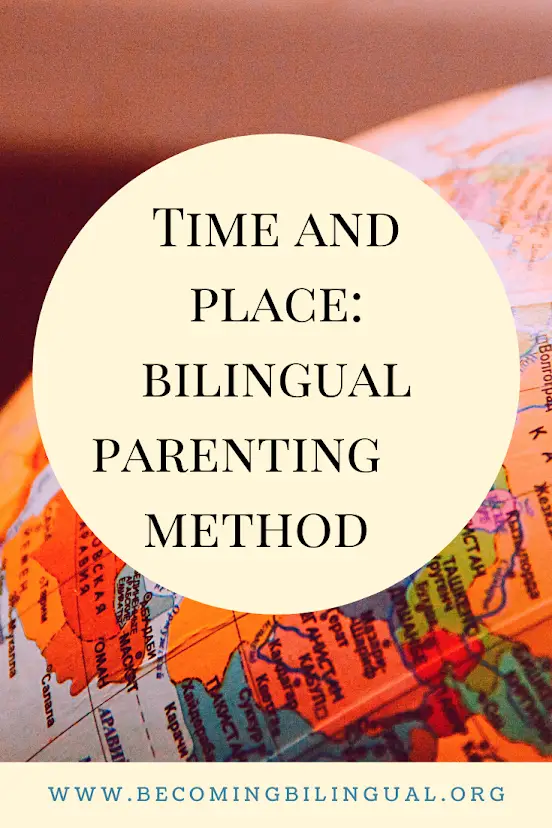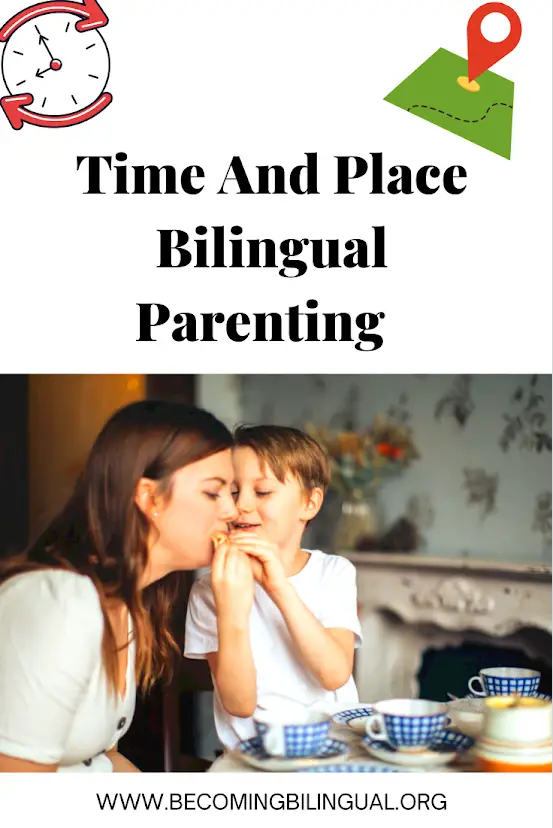Time And Place Bilingual Parenting Method

There are many methods for raising bilingual children. You may have heard of “one parent one language”, “minority language at home”, or “time and place”.
As you’re starting out on your bilingual parenting journey, it’s important that you find a bilingual parenting method that works for your family.
When I first started out on my journey to raise my daughter to be bilingual, my Spanish skills weren’t strong enough to support many of these methods. I didn’t have enough Spanish grammar or vocabulary to get me through a whole day of just speaking in Spanish to my daughter. I also didn’t have the resources to support a whole day’s worth of Spanish language at home.
I found that “time and place” (T+P) was a great way to start easing into a language. The T+P method allowed me to chunk our schedule into English times and Spanish times. Knowing that there was more structure to our language learning helped me to feel more productive about our Spanish language learning and it also allowed me to become more confident in my Spanish.
This article will explain the time and place bilingual parenting method, examples of time and place bilingual parenting, the benefits of using time and place and how my family used time and place bilingual parenting to start our language learning journey.

Table of Contents
What is the Time and Place method of bilingual parenting?
The idea behind ‘time and place’ (T+P) is that you work on speaking the minority language at a specific time each day or in a specific location. This method is really focused on scheduling the minority language into your life in a purposeful and clear way. It often works best when there is only one parent that speaks the minority language, or the parents are not yet fluent in the minority language.
Examples of using “time” as a language learning method
*The parent speaks the minority language in the morning before school and the majority language in the afternoons and at night.
*The family speaks in the minority language during the week and the majority language on the weekends.
*The parent picks a time in the routine to speak the minority language, for example, bath time or breakfast time. During that time, the family only speaks in the minority language.
Examples of using “place” as a language learning method
*The minority language is used in a specific place, like the car. Whenever the family gets in the car, they speak in the minority language together.
*Whenever the family is at the grandparents house, they speak the minority language with them.

The benefits of Time and Place
Segmenting your day for language learning can help make the task more manageable for a variety of reasons.
1. You learn vocabulary for a specific activity
When I first started to learn Spanish with my daughter, my Spanish vocabulary wasn’t very strong. Using the time and place method, I was able to pick a specific area of my vocabulary to work on.
The first “time” I picked was “bathtime”. That meant that, whenever I gave my daughter a bath, I would only speak in Spanish. Once I had made that commitment, I was able to narrow my Spanish research to water songs, bath songs, and specific phrases about the tub. Over the course of a few weeks, I had learned a startling amount of Spanish vocabulary about water and the tub!
The use of the time and place method gave me a specific set of vocabulary to research, learn and practice. Once I felt comfortable with my vocabulary around that part of the day, I felt like I could add another Spanish “time” to our day and tackle a new set of vocabulary.
2. You can maximize your language learning resources
Getting resources in a minority language can take a lot of research and effort. Using the time and place method can help you to narrow down what you’re looking for.
The first “place” that I chose with my daughter was the car. That meant that I needed resources to boost our Spanish language acquisition on the go. I researched Spanish songs, podcasts, and books on tape that we could listen to so that our Spanish time in the car would be easier to achieve.
Having a plan for what to look for, made looking for Spanish materials less overwhelming. I was able to target my goals for the car time and plan for that time to be in Spanish. As I added other times and places, I changed what materials I searched for.
Finding resources is a crucial way to build your language input. Read more about how to find resources that maximize your language learning time.
3. You can change times and places so that they work with your changing schedule
Family schedules are always changing and it can he challenging to commit to only one type of language learning. Time and place allows you to fit language learning into your family’s schedule and goals.
My original goal was to add more Spanish language times to our day and time and place was a great way to facilitate that. Once I was confident with my “bathtime” Spanish vocabulary, I was able to add more times of day like, “dinner time”. It’s also easy to change the times and places to focus on different vocabulary and different resources that you have.
To learn more about schedule language learning into your family’s day, check out this article on language scheduling!

For more information about the Time and Place bilingual parenting strategy, listen to this awesome podcast by Bilinguitos, which goes into detail about the method and also compares it to other popular bilingual parenting methods.
There are so many ways to incorporate a minority language into your life and time and place is just one of the many bilingual parenting approaches. What method has worked the best for your family?
Happy Learning!
Don’t forget to subscribe here and get the latest posts and resources delivered straight to your inbox!